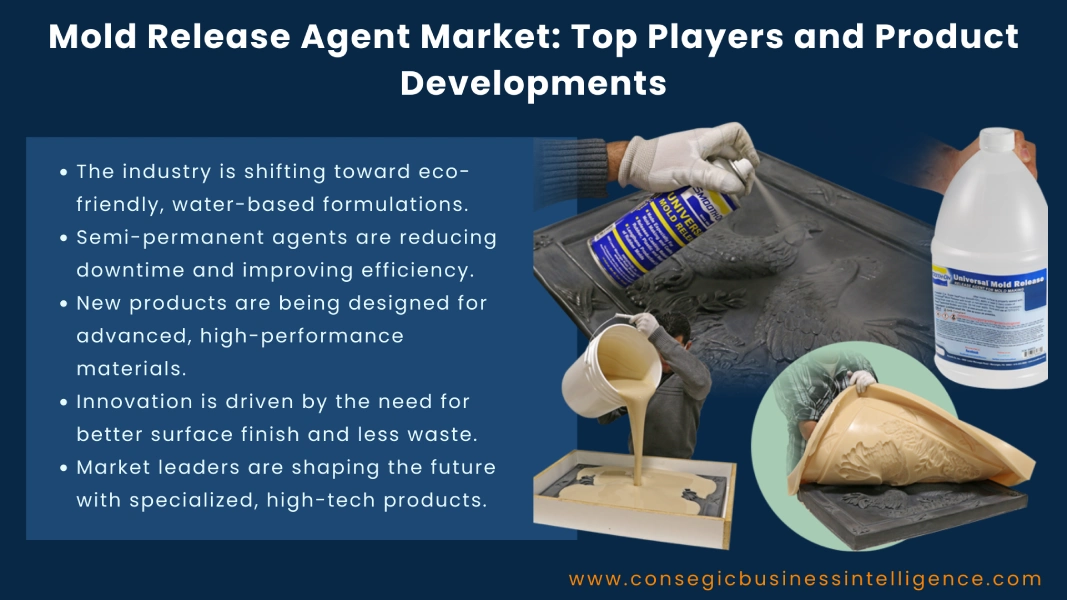Mold Release Agent Market: Top Players and Product Developments
Mold release agents are essential across plastics, rubber, composites, metal casting, and composite manufacturing. They prevent adhesion between a molded part and its tooling, protect surface finish, speed cycle times, and reduce scrap making them a small but critical component of efficient production. As manufacturers push for higher-quality finishes, tighter tolerances, eco-friendlier chemistry, and compatibility with advanced materials (like thermoplastic composites and high-performance elastomers), the mold release market is changing rapidly. Below are eight prominent global players and the recent product developments that are shaping the market.

- Dow Inc.
Dow supplies a wide range of release technologies including silicone-based, fluorosilicone, and water-dispersible systems targeting automotive, consumer goods, and industrial molding. The company is focused on formulating release agents that deliver consistent part surface quality while supporting faster cycle times in injection molding and thermoset processes. Dow’s R&D also emphasizes compatibility with automated dispensing and robotic application systems to support Industry 4.0 factory lines.
- BASF SE
BASF develops specialty additives and release coatings for plastics, polyurethane foams, and composite manufacturing. Recent development efforts center on multifunctional additives that improve mold release while enhancing surface properties such as gloss or paintability. BASF is increasingly integrating sustainability criteria by reducing volatile organic compounds (VOCs) and improving biodegradability, so that customers can meet stricter environmental and workplace-safety standards.
- Evonik Industries AG
Evonik’s portfolio includes silicone and non-silicone release agents tailored for polymer processing, rubber molding, and powder coatings. The company is investing in tailor-made chemistries for demanding applications like high-temperature moldings, medical-grade materials, and electrically insulated parts, where release performance must not interfere with downstream processes. Their focus on low-residue, low-impact chemistries addresses both quality and regulatory pressures.
- LANXESS AG
LANXESS concentrates on specialty polymer additives and mold-release chemistries for automotive and industrial elastomers. Its product development emphasizes release agents that function in high-volume rubber vulcanization and provide consistent release on coated or textured tools. LANXESS also works on improving thermal stability and reducing transfer to molded parts, which helps preserve cosmetic and mechanical properties of finished goods.
- Clariant AG
Clariant supplies release agents and process additives used in composite molding, fiberglass production, and thermoset processing. The company has increased work on water-based and bio-derived release systems that lower environmental impact without sacrificing performance in high-pressure molding or hand-layup composite processes. Clariant’s materials science approach often pairs release chemistry with mold-cleaning and maintenance solutions for improved tooling life.
- Momentive Performance Materials (Silicones)
Momentive is well known for its silicone technologies which provides silicone-based release agents and coatings that excel in surface finish and heat resistance. Their developments target specialty markets such as electronics encapsulation, aerospace composite molding, and high-gloss consumer products. Momentive also focuses on controlled-transfer silicones that minimize migration onto part surfaces, supporting downstream painting and bonding.
- Shin-Etsu Chemical Co., Ltd.
Shin-Etsu brings silicone and fluorinated chemistry expertise to release agent applications, especially where extreme heat or chemical resistance is required. The company designs release systems for advanced polymer processing, including high-temperature thermoplastics and specialty rubber compounds. Shin-Etsu’s strengths include scalable formulations that work across pilot and full-production tooling, helping customers shorten validation timeframes.
- Chem-Trend (Altana Group)
Chem-Trend is a specialist in mold release technologies with a strong presence in plastics injection molding, polyurethane processing, and compression molding. The company focuses on precision-applied release agents, metered systems and automated dispensers that reduce waste and ensure consistent coverage. Chem-Trend’s product development prioritizes low-residue and low-VOC formulations, plus solutions for multi-cavity molds and challenging high-gloss cosmetic parts.
Product Development Themes Shaping the Market
- Water-Based and Low-VOC Formulations: Across the board, suppliers are reformulating to reduce solvent content and lower VOC emissions. Water-based systems help operators meet environmental regulations and improve workplace air quality.
- Controlled-Transfer and Low-Residue Chemistries: New chemistries minimize transfer to finished parts which are essential for painted, adhesive-bonded, or overmolded components where surface contamination can cause failures.
- Bio-Derived and Sustainable Ingredients: R&D investment is increasing in bio-based release agents and biodegradable additives to address lifecycle sustainability and end-of-life concerns.
- High-Temperature and Specialty Polymers Compatibility: As manufacturers adopt engineering thermoplastics (PPS, PEEK) and advanced composites, release agents must resist extreme processing temperatures and aggressive chemistries.
- Metered, Automated Application Systems: Automation reduces human error and over-application; smart dispensers and robotic applicators ensure repeatable coverage and minimize waste.
- Tailored Solutions for Composites and Additive Manufacturing: Release systems optimized for prepreg, RTM, and 3D-printed molds improve surface fidelity and reduce post-processing.
- Regulatory and Occupational Safety Focus: Stricter workplace exposure limits and environmental rules are accelerating the shift toward safer alternatives and better process controls.
- Integrated Service Models: Vendors now offer tool-side audits, applicator training, and life-cycle support, helping customers optimize release performance and tooling longevity.
Conclusion:
The mold release agent market is evolving from commodity chemistry to a high-value, engineered-solution space. Major suppliers including Dow, BASF, Evonik, LANXESS, Clariant, Momentive, Shin-Etsu, and Chem-Trend are responding with low-impact, high-performance formulations and automated application systems that meet modern production, regulatory, and sustainability demands. As advanced materials and tighter surface tolerances become standard, successful release technologies will combine proven performance with environmental safety and process automation, thereby helping manufacturers improve quality while lowering costs and compliance risk.
